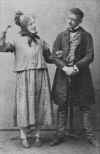Stage Musicals vs. History: G to K
by John Kenrick
(Copyright 2000, Revised 2003)
All photos below are thumbnails – click on them to see larger versions.)
George M!
 The Four Cohans: George M. is lower
right.
The Four Cohans: George M. is lower
right.
The classic 1942 film bio Yankee Doodle Dandy had to clean-up certain details to appease Cohan, but his daughter Mary was willing to be a bit more honest in 1969 when she worked on George M! The plot of this highly entertaining stage bio is bare-boned but fairly factual. It includes Cohan's divorce, his real wives, his vicious feud with Actor's Equity and his all-consuming egoism. It also celebrates Cohan's extraordinary creativity and multi-faceted talents – without which, his other qualities would hardly matter.
Goodtime Charley
The Joan of Arc story as a musical? Hey, there have been worse ideas. The brilliant opening number has the statues of dead royals on a cathedral wall come to life, explaining the convoluted "History" behind the show with wit and remarkable dramatic economy. In the show that follows, the basic details of Joan of Arc's victories and her betrayal by certain French leaders are relatively accurate. However, the chummy relationship between Joan and Charles is fanciful – nothing in the historical record suggests that Joan ever read her prince's beads the way she does in this libretto. The title and the casting of Joel Grey make Charles the lead, throwing the focus off what is really Joan's story.
Gypsy
 The real
Baby June (Havoc) and her sister Louise (a.k.a. Gypsy Rose Lee) with two of their
vaudeville "newsboys."
The real
Baby June (Havoc) and her sister Louise (a.k.a. Gypsy Rose Lee) with two of their
vaudeville "newsboys."
Arthur Laurents loosely based his marvelous libretto on the recollections of famed burlesque stripper Gypsy Rose Lee. Her sister June Havoc (the real "Baby/Dainty June") has never been too happy with the results, which were clearly slanted to make Gypsy look good. However, both daughters concurred that their mother Rose was a monstrous bitch who always put her show biz dreams ahead of everything else, including the well-being of her children. The girls toured in vaudeville for years. Eventually, June left the act against her mother's wishes to marry one of the boys. The unstoppable Rose kept Louise touring – and they did end up in burlesque when vaudeville died out. With her "intellectual" strip act, Louise renamed herself "Gypsy Rose Lee" and became the toast of Minsky's. After June's marriage failed, her mother and sister refused her any assistance. June Havoc survived the 1930s as a marathon dancer, then emerged as a successful stage and screen actress. By the way, the idea of a "Mr. Orpheum" is a great joke most audiences miss today. The Orpheum vaudeville circuit was built by Martin Beck and eventually taken over by E. F. Albee.
Harrigan 'n Hart
 Hart (in drag)
and Harrigan in The Little Frauds.
Hart (in drag)
and Harrigan in The Little Frauds.
The official participation of Edward Harrigan's daughter (Nedda Harrigan Logan) forced librettist Michael Stewart to fumble some facts. In the musical, Harrigan is painted as a total saint, Hart is seen as unstable, and Hart's wife is depicted as a calculating shrew who selfishly tears the partners apart. In truth, Harrigan's nepotistic habit of hiring unqualified relatives soured his partnership with Hart. The show never clarifies that Hart's untimely demise was caused by syphilis – delicately calling it an "unmentionable blood disease." What nonsense! And what a pity – real drama was weakened in the name of diplomacy. This show was only about 60 years too late, so other than Nedda, no one was particularly interested.
The King & I
Yes, a Victorian widow became schoolmistress to the Siamese court in the 1860s. However, the suggestion of any sort of romance between Anna Leonowens and King Mongkut is pure fiction. Victorian notions of race and social propriety would have made such a relationship unthinkable to both of them. Unlike the robust thirty-something Yul Brynner, the real King Mongkut was short, slender and 58 when Leonowens was hired. Anna did challenge the King on many issues, and frequently assisted him with his foreign correspondence. The letter offering Abraham Lincoln elephants to fight in the Civil War is quite real and occasionally on display at the Forbes Gallery in New York.
Anna pushed for the King to give her a promised brick residence outside the palace grounds – and she eventually got it. After five years teaching the royal family, she took a six-month leave to tour America – during which time the King died and 15 year old Prince Chulalongkorn assumed the throne. Anna never returned to Siam. Instead, she wrote a series of best-selling books based on her experiences there. Some were autobiographical, but the fictional tale of Tuptim and Lun Tha was based on fables told by the King's wives. Anna spent her later years as a writer, educator and leading suffragette in the U.S. and Canada. When her son Louis grew up, he returned to Siam and prospered as a businessman and close friend of King Chulalongkorn. After Anna's death, her stories inspired Margaret Landon to write the fictionalized Anna and the King of Siam. This book was the basis for the 1946 film of the same name (which changed many plot details) as well as Rodgers and Hammerstein's The King and I.
